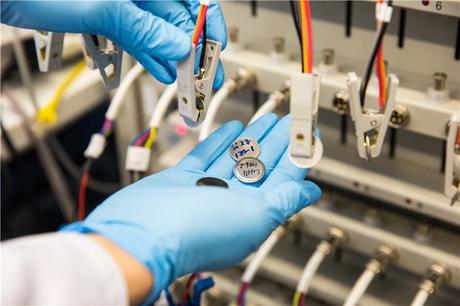Manufacturing microbatteries with organic electrode materials

With the rising popularity of smaller electronic devices, smaller energy storage systems are needed. Researchers from Aalto University have demonstrated the fabrication of electrochemically active organic lithium electrode thin films, which help make microbatteries more efficient than before.
When microbatteries are manufactured, the key challenge is to make them able to store large amounts of energy in a small space. One way to improve the energy density is to manufacture the batteries based on 3D microstructured architectures. This may increase the effective surface inside a battery dozens of times. However, the production of materials fit for these has proven to be difficult.
The Finnish researchers used a combined atomic/molecular layer deposition (ALD/MLD) technique to prepare lithium terephthalate, a recently found anode material for a lithium-ion battery. Their study has been published in the journal Nano Letters.
“ALD is a great method for making battery materials fit for 3D microstructured architectures,” said Mikko Nisula, co-author of the study. “Our method shows it is possible to even produce organic electrode materials by using ALD, which increases the opportunities to manufacture efficient microbatteries.”

The researchers’ deposition process for Li-terephthalate is shown to comply well with the basic principles of ALD-type growth, including the sequential self-saturated surface reactions, which is a necessity when aiming at micro-lithium-ion devices with 3D architectures.
The as-deposited films are found to be crystalline across the deposition temperature range of 200−280°C, which is a trait that is highly desired for an electrode material but rather unusual for hybrid organic-inorganic thin films. A good rate capability is ascertained for the Li-terephthalate films, with no conductive additives required.
The electrode performance can be further enhanced by depositing a thin protective LiPON solid-state electrolyte layer on top of Li-terephthalate. This yields highly stable structures with a capacity retention of over 97% after 200 charge/discharge cycles at 3.2°C.
Originally published here.
Predictive AI model enhances solid-state battery design
ECU researchers are working on ways to make solid-state batteries more reliable with the help of...
Boosting performance of aqueous zinc–iodine batteries
Engineers from the University of Adelaide have enhanced aqueous zinc–iodine batteries using...
Sodium-ion battery breakthrough boosts energy storage
Scientists have discovered that leaving water inside a key material, rather than removing it,...





